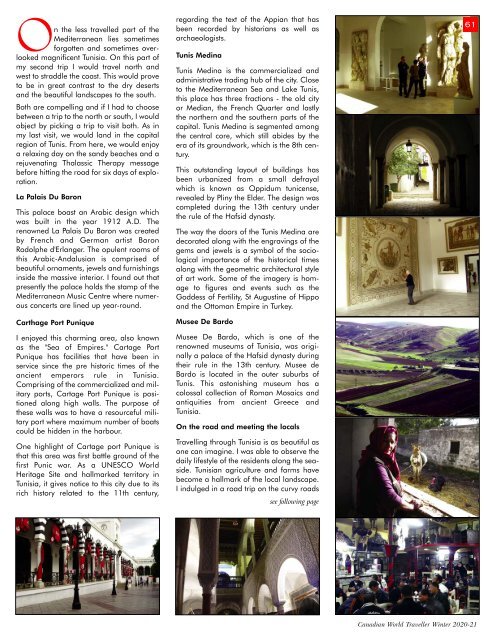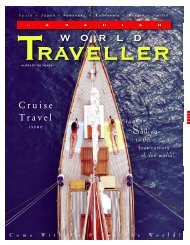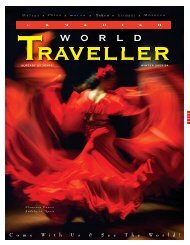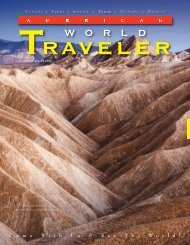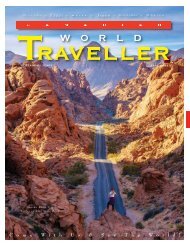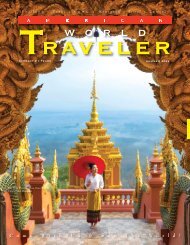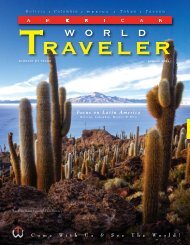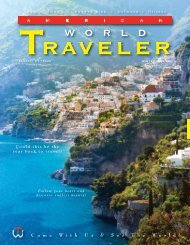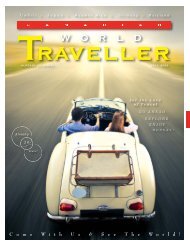Canadian World Traveller Winter 2020-21 Issue
Now in our 19th year of publishing, Canadian World Traveller explores the culture and history of worldwide destinations, sharing the adventure of discovery with our readers and motivating them to make their travel dreams a reality. Published quarterly, CWT helps sophisticated, independent Canadian travellers choose their next destination by offering a lively blend of intelligent, informative articles and tantalizing photographic images from our World’s best destinations, cruises, accommodations and activities to suit every traveller's taste.
Now in our 19th year of publishing, Canadian World Traveller explores the culture and history of worldwide destinations, sharing the adventure of discovery with our readers and motivating them to make their travel dreams a reality. Published quarterly, CWT helps sophisticated, independent Canadian travellers choose their next destination by offering a lively blend of intelligent, informative articles and tantalizing photographic images from our World’s best destinations, cruises, accommodations and activities to suit every traveller's taste.
- No tags were found...
Create successful ePaper yourself
Turn your PDF publications into a flip-book with our unique Google optimized e-Paper software.
On the less travelled part of the<br />
Mediterranean lies sometimes<br />
forgotten and sometimes overlooked<br />
magnificent Tunisia. On this part of<br />
my second trip I would travel north and<br />
west to straddle the coast. This would prove<br />
to be in great contrast to the dry deserts<br />
and the beautiful landscapes to the south.<br />
Both are compelling and if I had to choose<br />
between a trip to the north or south, I would<br />
object by picking a trip to visit both. As in<br />
my last visit, we would land in the capital<br />
region of Tunis. From here, we would enjoy<br />
a relaxing day on the sandy beaches and a<br />
rejuvenating Thalassic Therapy message<br />
before hitting the road for six days of exploration.<br />
La Palais Du Baron<br />
This palace boast an Arabic design which<br />
was built in the year 1912 A.D. The<br />
renowned La Palais Du Baron was created<br />
by French and German artist Baron<br />
Rodolphe d'Erlanger. The opulent rooms of<br />
this Arabic-Andalusian is comprised of<br />
beautiful ornaments, jewels and furnishings<br />
inside the massive interior. I found out that<br />
presently the palace holds the stamp of the<br />
Mediterranean Music Centre where numerous<br />
concerts are lined up year-round.<br />
Carthage Port Punique<br />
I enjoyed this charming area, also known<br />
as the "Sea of Empires." Cartage Port<br />
Punique has facilities that have been in<br />
service since the pre historic times of the<br />
ancient emperors rule in Tunisia.<br />
Comprising of the commercialized and military<br />
ports, Cartage Port Punique is positioned<br />
along high walls. The purpose of<br />
these walls was to have a resourceful military<br />
port where maximum number of boats<br />
could be hidden in the harbour.<br />
One highlight of Cartage port Punique is<br />
that this area was first battle ground of the<br />
first Punic war. As a UNESCO <strong>World</strong><br />
Heritage Site and hallmarked territory in<br />
Tunisia, it gives notice to this city due to its<br />
rich history related to the 11th century,<br />
regarding the text of the Appian that has<br />
been recorded by historians as well as<br />
archaeologists.<br />
Tunis Medina<br />
Tunis Medina is the commercialized and<br />
administrative trading hub of the city. Close<br />
to the Mediterranean Sea and Lake Tunis,<br />
this place has three fractions - the old city<br />
or Median, the French Quarter and lastly<br />
the northern and the southern parts of the<br />
capital. Tunis Medina is segmented among<br />
the central core, which still abides by the<br />
era of its groundwork, which is the 8th century.<br />
This outstanding layout of buildings has<br />
been urbanized from a small defrayal<br />
which is known as Oppidum tunicense,<br />
revealed by Pliny the Elder. The design was<br />
completed during the 13th century under<br />
the rule of the Hafsid dynasty.<br />
The way the doors of the Tunis Medina are<br />
decorated along with the engravings of the<br />
gems and jewels is a symbol of the sociological<br />
importance of the historical times<br />
along with the geometric architectural style<br />
of art work. Some of the imagery is homage<br />
to figures and events such as the<br />
Goddess of Fertility, St Augustine of Hippo<br />
and the Ottoman Empire in Turkey.<br />
Musee De Bardo<br />
Musee De Bardo, which is one of the<br />
renowned museums of Tunisia, was originally<br />
a palace of the Hafsid dynasty during<br />
their rule in the 13th century. Musee de<br />
Bardo is located in the outer suburbs of<br />
Tunis. This astonishing museum has a<br />
colossal collection of Roman Mosaics and<br />
antiquities from ancient Greece and<br />
Tunisia.<br />
On the road and meeting the locals<br />
Travelling through Tunisia is as beautiful as<br />
one can imagine. I was able to observe the<br />
daily lifestyle of the residents along the seaside.<br />
Tunisian agriculture and farms have<br />
become a hallmark of the local landscape.<br />
I indulged in a road trip on the curvy roads<br />
see following page<br />
61<br />
<strong>Canadian</strong> <strong>World</strong> <strong>Traveller</strong> <strong>Winter</strong> <strong>2020</strong>-<strong>21</strong>


